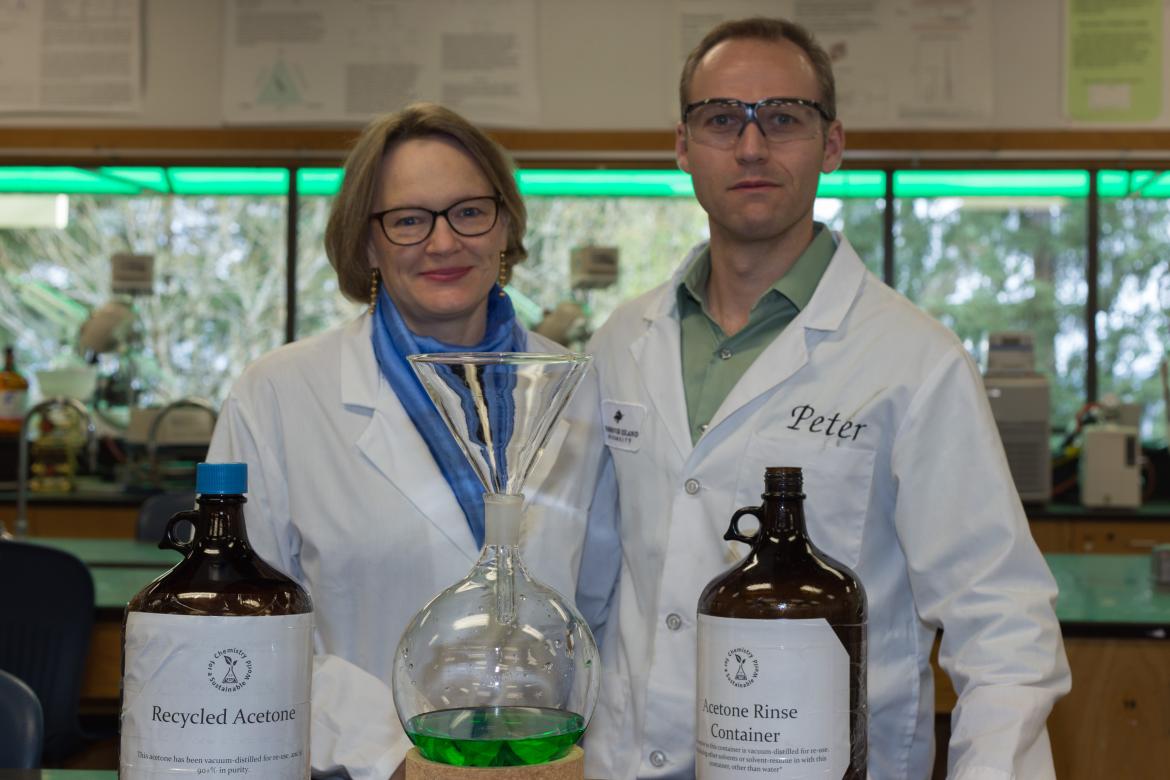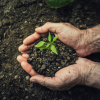
Dr. Alexandra Weissfloch, left, and Peter Diamente demonstrate that solvents are efficiently recycled in VIU chemistry laboratories – a step forward for environmental health and sustainability. Photo credit: Dennis Frost/Awden.com
March 8, 2017 - 3:30pm
Two institutions in Canada are now part of the Commitment, which ensures the implementation and adoption of green chemistry educational objectives at participating schools
Chemistry education at Vancouver Island University (VIU) is about to undergo a green transformation of a kind that only one other university in Canada has done so far.
VIU recently joined the Green Chemistry Commitment (GCC), a consortium launched by the non-profit Beyond Benign to design and develop innovative, efficient and environmentally sound chemical products and processes, and to prepare world-class chemists with 21st-century skills. It also aims to create systemic and lasting change in university-level chemistry education and increase the number of green chemists and scientists and the job opportunities available to them.
The second institution in Canada – the first being the University of Toronto – to sign on to the GCC, VIU joins about three dozen universities and colleges in the United States that are part of the consortium.
“This is a big step forward for VIU’s commitment to sustainability,” says Dr. Alexandra Weissfloch, a Chemistry Professor who spearheaded the University’s application to join the GCC. “It also means our chemistry program is going to be distinctive, not only in BC, but also in Canada. Being a small institution with small class sizes, our students will have the advantage of learning state-of-the-art chemistry with close student-instructor interactions and mentorship. It is a perfect fit for a department that is already strong in environmental chemistry.”
To join, all members of the Chemistry Department at VIU had to buy into the commitment, which is all about ensuring continuous improvements in waste and hazard reduction, as well as providing green chemistry education to students.
“We are focusing on reducing the amount of waste – both toxic and non-toxic – that our Chemistry Department uses,” explains Weissfloch. “It also means all our faculty members are going to ensure our chemistry students don’t leave VIU without an understanding of toxicology – how chemicals affect human health and the environment – and knowledge of chemicals and chemistry procedures that are less harmful for both.”
Chemistry students will still learn the same fundamental principles that are integral to a rigorous chemistry program, the only difference is that they will be taught to always look for more benign and less wasteful alternatives, she adds.
“The green chemistry education these students receive at VIU will help them make more informed decisions later, whether they find work as chemists, such as in the pharmaceutical, plastics, food or environmental industries; go on to become engineers, biologists or health-care workers; or simply better-informed consumers,” says Weissfloch. “It’s so important for chemists to become part of the solution. We tend to be acutely aware of global warming and crude oil being a non-renewal resource. While these are absolutely of paramount importance, it is also essential for us to become more aware of other issues. For example, numerous elements are in danger of being depleted and many of the everyday products we use are polluting our fresh water sources.”
Weissfloch, who started teaching at VIU in 2002, has a background in bio-organic chemistry. In 2012, she was granted a two-year leave to research green chemistry. When she returned, she developed a Green Chemistry and Toxicology course at VIU – the first of its kind, to her knowledge, to combine the two subjects in one course. She also developed workshops to help university and secondary school instructors integrate green chemistry education into their curricula.
With the help of other faculty members, Weissfloch made some of the University’s chemistry labs substantially greener, reducing waste by about 70% – a factor she thinks helped get VIU accepted into the GCC consortium. In a lateral move, green chemistry practices have been implemented in VIU’s Adult Basic Education classrooms, thanks to Science Instructor Glenda Hunter and several colleagues and students. Both Hunter and Weissfloch have travelled extensively to present on what they’ve learned about green chemistry.
“We’re still amongst the pioneers,” says Weissfloch. “There’s definitely work to be done, but there are no major barriers.”
Next up, green chemistry and toxicology are being worked into the Chemistry Department’s current degree planning proposal – VIU is building a new Health and Science Centre at the Nanaimo Campus, and with the new building, the institution will be able to offer a Major in Chemistry. Amy Cannon, Executive Director of Beyond Benign, says this is another reason why the GCC is excited to get VIU on board.
“It’s particularly exciting since the chemistry department is in the early stages of setting up a chemistry major and using green chemistry as a framework,” says Cannon. “This is essentially how we hope the future of chemistry departments will be structured, around green chemistry, since it is central to the future of sustainability. We believe VIU can serve as a model for other institutions who are also looking to build chemistry major programs centered around green chemistry.”
For more information about VIU’s Chemistry program, click here. Click here to learn more about the Green Chemistry Commitment.
-30-
MEDIA CONTACT:
Jenn McGarrigle, Communications Officer, Vancouver Island University
P: 250.740.6559 | C: 250.619.6860 | E: jenn.mcgarrigle@viu.ca | T: @VIUNews
SIDEBAR: The Do’s and Don’ts of Green Chemistry
(Based on the 12 Principles of Green Chemistry developed by Paul Anastas and John Warner)
- Don’t create waste
- Don’t have leftover or side products
- Don’t use or produce toxic and dangerous substances
- Do design new, more benign products that work as well as the old ones
- Don’t use any non-essential additives
- Do reduce energy consumption
- Do use materials from renewable sources
- Do reduce the number of steps to make the product
- Do use methods that are reusable and speed up the process
- Do use substances that readily break down and become innocuous in the environment
- Do monitor all steps in a timely manner to prevent hazardous product formation and wasted energy
- Do ensure that safety comes first
*Want to find out how your household products stack up when it comes to human health and the environment? Check out this website created by the US Department of Health and Human Services. The site includes information on products ranging from home maintenance and arts and crafts products, to pet care and automotive products.
Tags: Teaching and Learning






